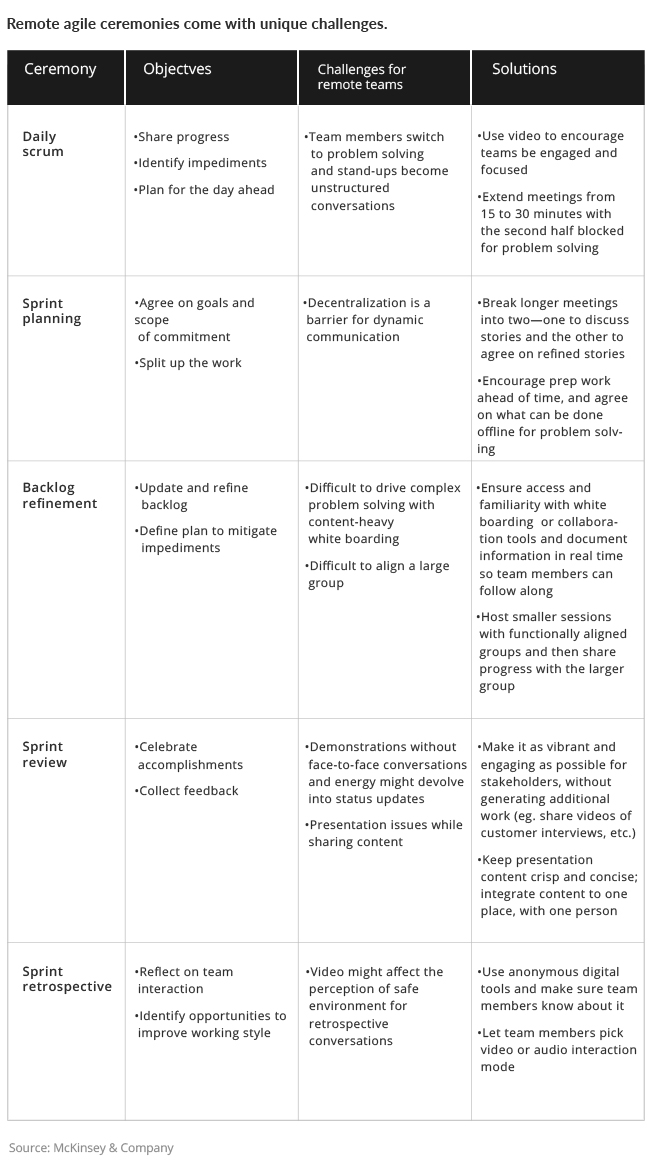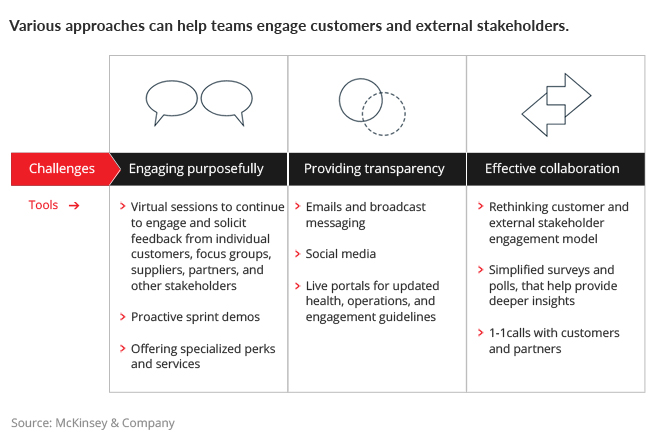Revisiting Agile Teams After an Abrupt Shift to Remote
As organizations adapt to the ongoing COVID-19 crisis, their agile teams can be a real source of competitive advantage. Such teams are typically well suited to periods of disruption, given their ability to adapt to fast-changing business priorities, disruptive technology, and digitization.
Here’s how to ensure they’re effective now that COVID-19 has forced them to work remotely.
1. Sustaining the people and culture of a remote agile team
Remote work for agile teams requires a considerable shift in work culture. It takes a more purposeful effort to create a unified one-team experience, encourage bonding among existing team members, or onboard new ones, or even to track and develop the very spontaneous ideas and innovation that makes agile so powerful, to begin with.
2. Revisit the norms and ground rules for interaction
Virtual whiteboards, instant chat, and videoconferencing tools can be a boon to collaborative exercises and usually promote participation. But they can also require teams to reconsider existing norms and agreed-upon ground rules. Some challenges may require team members to adjust to the tools themselves: team members should be generous with one another in offering practical support on navigating virtual tools—such as help formatting or recording presentations or informing the host about any technology issues. Teams need to get up to speed quickly on visual management and virtual whiteboarding and tailor established ceremonies into standard virtual routines. New ground rules for communication may be needed to keep people who are interacting virtually from talking over one another. Importantly, teams need to be respectful of personal choices. Working from home blurs the lines.
3. Cultivate bonding and morale
Many of the kinds of activities that nurture morale for co-located agile teams—such as casual lunches, impromptu coffee breaks, or after-work social activities—are not possible in a virtual environment. Team members should encourage one another to introduce their pets and family members and to show any meaningful items in their working space. Working remotely, teams need to make a more conscious effort to be social, polite, precise, and tactful—to ensure everyone feels just as safe contributing remotely as they did in person. Agile teams working remotely may also require a more deliberative focus on empathy, openness, respect, and courage.
4. Adapt coaching and development
With coaching, agile teams should aspire to model remotely everything they would have done in person—but more frequently, given the abruptness of the switch to remote format. If you would do one-on-one coaching over coffee, try doing it remotely—while actually having coffee over video. Encourage all team members to turn on their video and actively monitor body language during group meetings, especially those in the role of a coach.
5. Recalibrating remote agile processes
The challenge for remote agile teams is that they’ll be tempted to try to replicate exactly whatever has worked for them in a co-located setting. But what worked in the office setting won’t always work remotely. The trick is to work backwards—start with the outcomes you were getting in the office and modify your scrum ceremonies as appropriate.

6. Establish a single source of truth
Working remotely, teams may need to consider a different approach to documenting team discussion—producing a so-called single source of truth to memorialize agreements. This can then be kept in a single shared workspace. A remote stand-up can be more involved than an in-person one, depending on a team’s cohesiveness and it’s maturity. If team members don’t all participate in the event—or if there’s a risk that they’ll be distracted during the call—then it’s important to calibrate the process to the context. The right approach is likely to be team specific, depending on team maturity and existing norms. Others might find it sufficient to simply submit their notes to a shared online workspace, with a bot to collect and compile everything for the records.
7. Adjust to asynchronous collaboration
Asynchronous communication, such as messaging boards and chat, can be an effective means to coordinate agile teams working remotely. In fact, we have already seen some teams replacing certain traditional ceremonies with asynchronous communication. For example, a team in a services institution has replaced some of the daily huddles by a dedicated messaging channel to which team members submit their updates and identify impediments to further work. This has the benefit of allowing team members to raise red flags at any point during the day, and it serves as the registry of concerns that have been raised and addressed. Note that asynchronous communication needs to be used carefully. Teams that grow overly reliant on asynchronous channels may see team members feeling isolated, and the trust among them may suffer.
8. Keep teams engaged during long ceremonies
A remote-working arrangement creates new challenges in keeping agile teams motivated and avoiding burnout. Working in isolation is hard for any person, but particularly for agile teams accustomed to face-to-face communication and frequent interpersonal engagement. Multitasking and home-based distractions also take a toll, depending on how things are set up. At one US financial institution, for example, a scrum master realized that staring at a video screen for more than a couple of hours was draining without the dynamic interaction of an in-person workshop. Her solution? For longer meetings, she began to schedule in a ten- to 15-minute exercise break every 90 minutes—with a shared videoconference tool to recommend different exercises.
9. Adapting leadership approach
The core mission of leadership stays the same, whether co-located or remote. But leaders need to be more deliberate when engaging with customers and teams, especially when you have limited in-person interaction. Leaders in this context can be anyone on the team, whether product owners, scrum masters, or even a developer demonstrating leadership. They also need to be purposeful at engaging external customers and stakeholders. They must be transparent and reassuring in their communication about team performance and objectives. The tools and approaches can vary. But the individuals and interactions should be the main consideration. Leaders need to show, in their tone and approach, that everyone is in this together.

The abrupt shift to a remote-working environment was a dramatic change that particularly affected agile teams. The hope is that these changes won’t be permanent. But for now, teams can reinforce productivity by taking a purposeful approach to sustaining an agile culture and by recalibrating processes to support agile objectives while working remotely.






